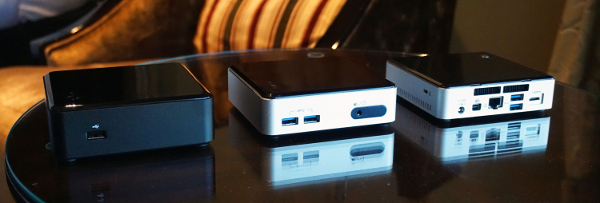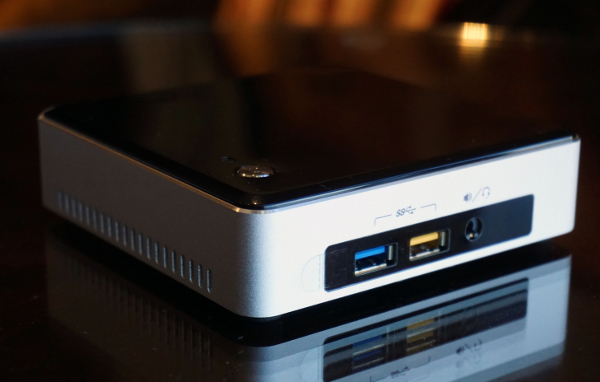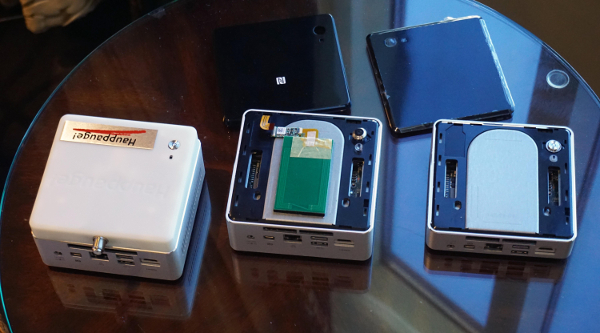Intel Reveals A Refreshed Line Of NUC Mini-PCs
Intel announced the new NUCs, which, unsurprisingly, aren't drastically different from their predecessors.
NUCs are small form factor computers, for which you need to add memory and storage. They can be used for light-use living room PCs, streaming boxes, to power kiosks and so on.
In addition to its fifth generation of Core processors, Intel also announced its new lineup of NUCs (Next Unit of Computing). Naturally, these NUCs run on the new Broadwell processors, specifically the U-series parts for efficient operation with a low heat output.
Compared to their predecessors, the new NUCs feature a couple of small changes. Visually, they're slightly shorter than the last generation, with a 30 mm Z-height, and they have a new black area around the front I/O. The new NUCs also now have a yellow USB port, which is a charging-capable USB 3.0 port. The I/O remained consistent with the previous lineup, with four USB 3.0 ports, gigabit Ethernet, an audio jack that doubles as a microphone jack, mini-HDMI and mini-DisplayPort.
We would have liked to see Intel return to the standard HDMI port plug, as it appears that it would fit just fine, but it offers much greater cable compatibility.
The tops of the NUCs are swappable, and one of them was demonstrated with NFC capabilities and another with a Hauppauge! TV tuner. Additionally, the NUCs will be available in variants with support for a 2.5-inch drive, Core i5 or Core i3 processors, and an i5 version with Intel vPro. There is also a variant with an extra DisplayPort 1.2 port for extended multi-monitor support. For connectivity, there's 802.11ac (Intel's dual-band 7265).
A bit later on down the road, Intel said that there will be a Core i7 version with HD 6000 graphics.
All things considered, this isn't a major or revolutionary new launch, but rather just an incremental update. If you were in the market for a NUC before, and were happy with what the previous NUCs offered, don't feel bad for grabbing one for the cost savings they will potentially offer. If you were looking for a bit more power, however, the new models will probably offer a decent percentage increase over their predecessors, as we saw in the benchmarking of the new U-series processors.
Get Tom's Hardware's best news and in-depth reviews, straight to your inbox.
Follow Niels Broekhuijsen @NBroekhuijsen. Follow us @tomshardware, on Facebook and on Google+.
Niels Broekhuijsen is a Contributing Writer for Tom's Hardware US. He reviews cases, water cooling and pc builds.
-
Christopher1 Do these NUC's perform about as well as a laptop with the same equipment? If so, this might be good for people like myself who like to have a 'spare' computer just in case something happens to our main laptop or computer.Reply -
Snipergod87 Whats with the one in the middle that appears to have a small battery pack. Is it a small battery pack or something else.Reply
It appears to small to power the machine, maybe to be used to charge devices on the charging port? (That would see odd though). Unless its for NFC -
Eximo That green board and little module plus header looks very similar to other NFC products, so I think you are right.Reply
Can't find one that looks quite like it though (Been trying to pick between NFC and Bluetooth Low Energy for a project) -
Gnox I purchased a generation before this NUC and my wife and I have been very pleased. We use it as a typical home computer (word processing, streaming video, Skype, etc). It is very comparable to a laptop the only difference is that you can have a large monitor. We added a wireless keyboard and mouse. Mounted the NUC on the back of the monitor and it is a super clean install.Reply
-
BulkZerker Gnox. I'm glad it works well for you. I wanna do the same but with an AMD based part for light gaming.Reply -
brainiac88 @Christopher1 - Yes, NUCs use the same Core CPUs as typical UltrabooksReply
Yes that green module is a 3rd-party NFC module. It is an _example_ of what 3rd parties can do / integrate with 3rd-party replacement lids.
@BulkZerker - A Rock Canyon i5 with HD Graphics 6000 has more than enough performance for light gaming, and certainly much more than AMD. And when the i7 comes out, it will have Iris Graphics 6100 -
sonofliberty08 i still prefer the Xiaomi Mi Box ARM/Android based set-up box over this intel x86 based mini-pc.Reply -
patrickjp93 @brainiac88, Given how much Intel Gen8 iGPU has improved in many benchmarks, it's quite possible Iris Pro 6200 will be more than enough for light gaming. Nicer NUCs with it will be out in a couple months.Reply -
milkod2001 If this will be equipped with Brodwell it'll be even more expensive and less attractive as it already is. It's basically laptop with no keyboard based on low-mid level CPU. If Intel wants us to spend $800-1000 for this make it 2 times bigger as already is, put Quad Core Haswell + 980m and big but very quite 90mm fan. That would be enough for not only light 720p gaming but more then enough for 1080p gaming, a bit of production work too. Intel's NUC are currently barely good enough for office and browsing, multimedia = cheap laptop is better option than this.Reply



